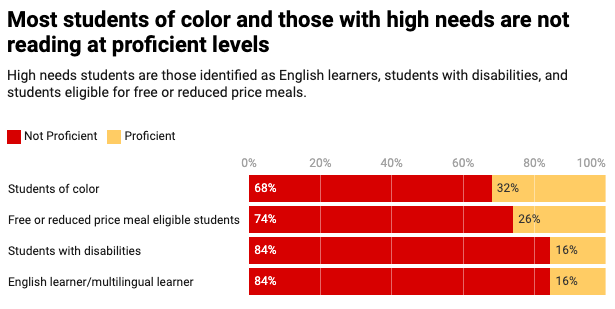Connecticut’s Right to Read Law Faces Criticism. The State is Pushing Back
Some superintendents said the state’s process to request a waiver was confusing and inconsistent, with one calling the law overbearing.

Get stories like this delivered straight to your inbox. Sign up for The 74 Newsletter
With more than half of the state’s third-graders failing to meet reading benchmarks, education stakeholders across the state agree that existing strategies must change in order to boost student scores.
How to go about that change is where the consensus ends.
State education officials are doubling down on their support of a piece of legislation that they believe will provide equal opportunity for all children learning how to read, despite local school leaders’ misgivings about the implementation of the law.
Officials at the state Department of Education have embarked on a “myth”-busting tour recently, arguing that school superintendents’ public complaints about the process created to carry out the Right to Read law are rife with misinformation.
According to data from the department, over 19,500 students in the third grade are not reading on grade level. That figure represents about 54.5% of third graders statewide, where even in Connecticut’s highest performing districts, about 25% of students are trailing benchmark goals.
“The bottom line is this is something that we have to work on consistently across the state and across all school districts,” said Education Commissioner Charlene Russell-Tucker at the state Board of Education meeting earlier this month. “If we do nothing different, these are the numbers we’re [going to continue] producing year after year, and that is not acceptable. We’ve got to do something about it.”
During the 2023 legislative session, lawmakers passed the Right to Read bill, which will require that all Connecticut school districts shift to a reading program aligned with the Science of Reading — a body of research that shows the best way to teach reading is through five pillars of skill development: phonemic awareness, phonics, oral reading fluency, vocabulary and comprehension.
The legislation outlined that the state Department of Education would choose a number of programs that adhere to the Science of Reading for districts to choose from and fully implement by 2025. Eighty-five districts and charter schools applied for a waiver, arguing that their existing curriculum met state standards or that they wanted to try a different program.
Only 17 of the 85 school systems fully met the state’s standards, which prompted a vocal reproach from many district leaders who were denied waivers.
Superintendents from Greenwich, Westport and Southington — all of which requested but did not receive waivers and have some of the highest reading scores in the state, between 64% and 74% proficiency — said they do not oppose the evidence-based reading models but are critical of the department’s mandates and processes.
“We have been implementing new resources for the past five years. We have invested heavily in resources, teacher training, and a commitment to all students finding the highest level of success,” said Greenwich Superintendent Toni Jones. “The concern is that the review of district programs already on this pathway for several years is being threatened by ‘approved’ box programs required by the CSDE instead of evaluating outstanding instructional practice and materials in use right now. The legislation is strong, supported by educators, and scientifically supported, [but] the process for evaluation is severely flawed.”
Several district superintendents shared similar sentiments and added that the waiver requirements changed midway through the process and that the application was confusing.

Teachers across the state agree with the legislation’s intent to improve reading scores for all students, but they’ve also voiced frustration about being left out of the conversation.
“Where’s the emphasis on developing plans that can be modified to meet the kids? Where is the conversation about building our capacity around literacy, making sure that our teachers have the opportunity to build really dynamic lessons, and that they have the opportunity to learn from one another?” said Kate Dias, president of the Connecticut Education Association, the largest teachers union in the state. “We’re not having those conversations, [instead] we’re talking about which workbooks are the children using.”
Mainly in response to some superintendents who had spoken to news outlets following the waiver decisions in December, representatives from the Department of Education held a ‘Myth versus Fact’ presentation at the recent state Board of Education meeting where they emphasized the implementation process was unbiased, unchanged and aligned with legislation. The state also held a three-hour panel on Jan. 25 with national, statewide and local stakeholders about the importance of aligning evidence-based reading programs and curriculum.
“This is a basic civil right, and we’re going to make sure that regardless of background, everybody has that skill,” Gov. Ned Lamont said at the panel. “I think [reading] gives every one of our kids a little bit more of a head start in life. I think that’s what we’re trying to do here with this legislation and trying to get that implemented. … This is best practices, what Charlene is trying to do is say, ‘Look, these are the very best ideas, this is what seems to be working in other jurisdictions. Try this out in your community.'”
Lawmakers and other representatives from the education department continue to argue that narrowly-focused criticisms about the implementation of the law has distracted from its true purpose, and instead, the focus should be on celebrating the shift in curriculum as “a win for the entire state of Connecticut.”
“If we can demonstrate that we are providing the necessary tools for our students to have a high-quality learning experience and to get them proficient in reading and learning how to read from pre-K to three, then we’ve done our job,” Rep. Jeff Currey, the co-chair of the Education Committee, told The Connecticut Mirror.
The Science of Reading
The Science of Reading refers to decades of research in education, psychology and neuroscience and its findings on how children best learn reading skills.
Most states have shifted toward or implemented some type of legislation regarding evidence-based reading instruction, most notably in the south, including Mississippi, which has garnered national attention for significant reading scores improvement in the last decade.
“Mississippi went from being ranked the second-worst state in 2013 for fourth-grade reading to 21st in 2022,” The Associated Press reported in May 2023. Louisiana and Alabama, two other states that have implemented similar legislation, “were among only three states to see modest gains in fourth-grade reading during the pandemic, which saw massive learning setbacks in most other states.”
Russell-Tucker told members of the Black and Puerto Rican Caucus at a meeting in mid-January that Connecticut is one of at least 32 states that implemented policy related to evidence-based reading instruction.
“However, by our count, we’re up to about 19 states, including D.C., that are actually doing very specific mandates of evidence-based reading instruction that must be implemented by school districts,” Russell-Tucker said. “So, Connecticut is not alone in this regard.”
The legislation’s goals
Melissa Hickey, the reading and literacy director for the state Department of Education, told the CT Mirror that the Right to Read legislation was a collaborative effort with the Black and Puerto Rican Caucus.
“There has been many pieces of legislation in place around reading and supporting literacy with professional learning and having coaches go into districts and support,” Hickey said. “This ‘Right to Read’ actually brought it to a newer level where programs, curriculum models and compendium were included in the legislation. So — really looking at the core comprehensive materials that schools are using and ensuring that they are research-based.”
Of the 19,500 Connecticut third-grade students who are reading below proficiency, 12,900 are students of color and over 14,500 are high-need students — meaning they qualify for free or reduced lunch, are English language learners or are students with a disability.
“A child learning to read is a civil rights issue,” said Sen. Patricia Billie Miller, D-Stamford, the chair of the Black and Puerto Rican Caucus. “We have a responsibility … to make sure that children in this state can read. Frederick Douglass said that when you can read, you’re forever free.”

“An Act Concerning the Implementation of Reading Models or Programs” passed as part of omnibus education bill Senate Bill 1 and lays out that local boards of education must partially transition to a state-approved reading program by 2024 and fully by 2025.
“We’re leaving behind 19,000 of our learners, and this [legislation] is about applying the findings of what we know about how our little ones’ brains work to learn how to read and ensure every district is teaching in that way, even districts that believe that they’ve got some special sauce already,” said state Board of Education chair Karen DuBois-Walton. “This is about ensuring that every district is equipped with what we know is the right way to teach kids to learn to read.”
The approved programs were required to be evidence- and scientifically based and “focused on competency in the following areas of reading: Oral language, phonemic awareness, phonics, fluency, vocabulary, rapid automatic name or letter name fluency and reading comprehension,” according to the legislation. The department ultimately provided over a handful of programs for districts to choose from.
As implementation continues, Dias said, she hopes the conversation will shift from what programs were chosen to how it’s actually working in the classroom.
“Currently, the entire conversation is focused on ‘What are the materials?’ and for me, the materials are the last piece of the puzzle, not the first. The first piece, to me, is what are the intentional outcomes we want from our literacy programs? Have we all agreed universally of what that is, and did we rebuild a curriculum to guide us to that pathway?” Dias said. “The real solution of how do we get to the end game, for me, is, I’m looking for the opportunity to bring talented educators to the table and give them the space to build a model curriculum that could be utilized within the state of Connecticut.”
Similarly, Charles Hewes, the state deputy commissioner for academics and innovation, said that on paper, aligning statewide reading curriculums may look like the first step toward improving literacy rates in Connecticut but that the results will begin with teacher support and resources.
“First step is to support our teachers with resources that are aligned with the Science of Reading. Another step is to make sure that they have the professional learning support as needed to implement those resources,” Hewes said. “Third, sustainable leadership and community support. Fourth, they need appropriate assessments that really draw on student needs. … These are all pieces of a bigger picture of implementation.”
Hewes and Hickey both added that the department has begun meeting districts one-on-one to help plan for their needs. The state Department of Education has also met with members of the Connecticut Association of Public School Superintendents and continues to partner with the University of Connecticut, HILL for Literacy and others to provide free professional learning.

Districts raise concerns
Much district dialogue has been centered on the waiver process rather than the Science of Reading, which most districts agree is a successful way to teach early literacy skills.
Districts including Hartford, Waterbury and New London public schools were approved for waivers, despite only reporting 14.5%, 19.1% and 26.1% of their respective third-graders were able to read proficiently.
The majority of districts that applied for waivers were rejected, and the decisions triggered confusion for superintendents in towns that have a higher percentage of students meeting reading proficiency scores.
Hewes said, however, that reading scores were not considered in the waiver process and that some districts — such as Hartford — plan to implement new and innovative reading programs that are different from what they’ve been using.
“Hartford took advantage of the waiver process to have what they wanted to implement reviewed by experts before they made any shift,” Hewes said. “It’s really important to emphasize that we were looking for alignment to the areas of reading in the legislation, and that was the function of the waiver process. It was not an evaluation of the performance of a district.”
Hartford, specifically, was approved to use a core curriculum called Wit and Wisdom, which the district said was the best fit to “meet the unique needs of our students and satisfy the guidelines outlined in the new legislation based on the Science of Reading.”
“Now that the waiver has been approved, we are excited to implement the new core curriculum on behalf of our students and teachers,” said Hartford Superintendent Leslie Torres-Rodriguez. “This new compendium of curriculum resources, in alignment with scientific research, will benefit our students and improve early childhood literacy across the district.”
But other superintendents, who weren’t successful in the waiver process, said the state’s process was confusing and inconsistent. Some superintendents also consider the new legislation overbearing.
“My concern has less to do with shifts to our programs or curriculum to purposefully align with the Science of Reading and more to do with the state mandating curriculum and programs from the top down,” said Southington Superintendent Steven Madancy. “Connecticut has always been a local control state, and recent actions fly in the face of that.”
In Greenwich, the superintendent called the evaluation rubric “frustrating and minimalistic.”
“The waiver was a very confusing process, with many moving finish lines,” Jones said, adding that the state’s evaluation team changed during the process, and they implemented a new evaluation criteria that “nobody knew about.” She also said that the rubric commented on old materials from 2018 that were not relevant to the practices the district has currently been using.
Westport Superintendent Thomas Scarice shared similar sentiments, as he felt the process was “ill-defined from the beginning.”
“Whether districts were approved for the waiver had little to nothing to do with their actual program, alignment to the research or outcomes for students,” Scarice said. “The implementation by the state Department of Education was convoluted, inconsistent and most importantly not aligned to the actual statute, leaving our district, and perhaps a number of other districts, confused. The response provided by the CSDE to our waiver was incomplete, portions were left blank and the narrative responses were difficult if not impossible to comprehend.”
Representatives from the state Department of Education called several superintendents’ criticisms “myths” at a recent state Board of Education meeting and presented a slideshow that countered the allegations.
“A myth: the waiver review tool changed throughout the process. We heard this multiple times, please know that the actual fact is it did not change. … The waiver tool remained the same. The waiver tool aligned to the legislation and the guidance that was provided to districts aligned to legislation,” Hickey said. “Another myth: the process was biased. Please, know again, … it was double blind. It was conducted by experts in literacy with no ties to Connecticut or to any districts in Connecticut.”
Hewes added that some claims “can be harmful,” to both the people “trying to execute the legislation but also education as a whole and what we try to do for our kids.”
“If we know the Science of Reading research tells us how to instruct students, wouldn’t we all want to be finding a way to make sure that we’re as closely aligned to that research in the materials and curricula that we use?” Hewes told the CT Mirror.
Scarice and Jones both said that their reading curriculums are aligned with the Science of Reading and that they’ve requested the department’s reconsideration.
Russell-Tucker presented a similar ‘Myth vs Fact’ slideshow to the leaders of the Black and Puerto Rican Caucus on Jan. 16 where lawmakers asked Russell-Tucker and her team for a follow up meeting to “take a deeper dive” into where the legislation is and existing criticisms and pushback.
Last week, the Department of Education also held a panel at the Legislative Office Building called the “Education Forum on Literacy: A State & National Conversation.” The panel was made up of several lawmakers who are part of the Education Committee, national advocates and a handful of local education leadership, including a principal and reading specialist from an elementary school in Plainfield and the Hamden superintendent.
Prior to the event, there was criticism from CEA, which said it wasn’t approached about having educators be a part of the conversation. Nevertheless, Dias said, she remains optimistic about the partnerships working to improve literacy throughout the state.
“We have a lot of people who feel passionately about improving our literacy in the state of Connecticut, and that is a good thing,” Dias said. “And while things might feel a little uncomfortable today, because we don’t all feel in the same place, the fact is, we all want the same thing, and that is really positive. We’ll get there, and today this [change] is uncomfortable, and it’s difficult, but I remain optimistic.”
This story was originally published on Connecticut Mirror
Get stories like these delivered straight to your inbox. Sign up for The 74 Newsletter

;)